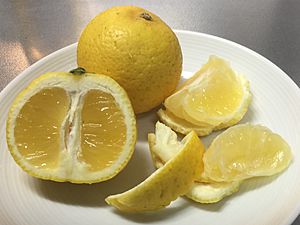Ōgonkan facts for kids
Quick facts for kids Ki-mikan (黄蜜柑) or Ōgonkan (黄金柑) |
|
|---|---|
 |
|
| Ōgonkan grown in Ehime Prefecture | |
| Scientific classification | |
| Kingdom: | |
| (unranked): | |
| (unranked): | |
| (unranked): | |
| Order: | |
| Family: | |
| Genus: | |
| Species: |
C. flaviculpus
|
| Binomial name | |
| Citrus flaviculpus hort. ex. Tanaka |
|
Ōgonkan (黄金柑, "golden citrus") or Ki-mikan (黄蜜柑, "yellow mikan") are special types of Japanese citrus fruit. They are small and have a bright, shiny yellow skin, which is why they are called "golden citrus" or "yellow mikan."
A scientist named Chōzaburō Tanaka once called this fruit Citrus flaviculpus. But most experts today prefer a different way of classifying citrus fruits. You might also see its name spelled as "Ougonkan" or "Ogon-kan." In some places, like Kanagawa Prefecture, people even call it "Golden orange."
A Look at History
This unique citrus fruit has been known for a long time in Kagoshima Prefecture, where it's called Ki-mikan. However, no one knows exactly where it first came from.
One story says that people in an area now called Hioki, Kagoshima have known about this fruit since the Meiji Period, which was a long time ago. Some old tales suggest it was brought to Japan by a Jesuit missionary named Francis Xavier or even from the Korean Peninsula during wars in the late 1500s. Another idea is that the name "Ōgonkan" was given by error: {{nihongo}}: Japanese or romaji text required (help), who introduced the fruit to Ehime Prefecture. But these stories are not fully proven.
The Fruit Itself
The Ōgonkan fruit is quite small. It is usually about 4 to 5 centimeters (about 2 inches) wide. Each fruit weighs around 60 to 80 grams (about 2 to 3 ounces). Its skin is a very bright yellow, and while you can peel it by hand, it can be a bit tricky.
This fruit has a special, strong smell and tastes very sweet. It also has a little bit of sourness, which balances the sweetness perfectly. Farmers usually pick these fruits from February to April. Sometimes, you might find fruits that don't have any seeds inside.
The smell of Ōgonkan is a bit like another yellow citrus fruit called Hyuganatsu, but Ōgonkan is usually sweeter. Just like with Hyuganatsu, you can actually eat the white part of the peel, called the pith.
Scientists have studied the oil from the Ōgonkan's skin to understand its smell. They found that it contains chemicals like limonene, which is a common scent in citrus. These chemicals are similar to those found in Hyuganatsu peel, but in different amounts.
Where It Grows
The Ōgonkan is grown in several parts of Japan. In 2010, Japan produced a total of 137.3 metric tons of this fruit. Most of it, about 108.2 tons, was sold fresh in markets. It wasn't usually used to make juices or other processed foods.
Kanagawa Prefecture grows the most Ōgonkan, producing about 68% of the country's total. Shizuoka Prefecture is next, followed by Ehime Prefecture and Kōchi Prefecture. Some of the main areas where it is grown include Odawara, Kanagawa and Yugawara-cho in Kanagawa, Numazu, Shizuoka, and several cities in Ehime, like Uwajima and Imabari.
Creating New Fruits
The Ōgonkan fruit has been used by plant breeders to create new types of citrus. For example, it was one of the "parents" for a new fruit called Hime-Koharu (媛小春), which was developed in Ehime Prefecture. It was also the "seed parent" for another new fruit called Shonan Gold, created in Kanagawa Prefecture. This shows how important Ōgonkan is for developing exciting new citrus varieties!

